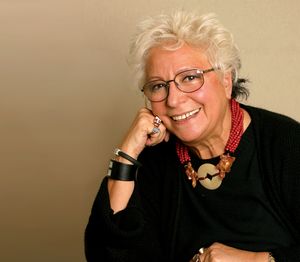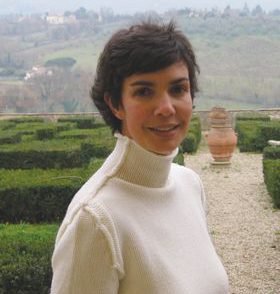The Ferragamo flagship on Santa Trinita, in the heart of Florence, houses more than designer shoes and bags. It is also home to the newly renovated design museum, Museo Salvatore Ferragamo. And it’s not solely a shoe museum, as many would think. It is a museum which celebrates passion and creativity, a museum built to preserve memories and design and to inspire and educate future generations. It tells many stories, applauds celebrity, promotes contemporary art and culture, and leads you through the past while dreaming of the future.
In addition to the museum’s new space and most recent exhibit, Creativity in Color, curated by Stefania Ricci, the Ferragamo team fashioned a unique retail space. Modeled after a 1950’s atelier, this store contains shoe and bag designs from past collections. The museum goes a step further: it is the only place in the world where people can actually purchase the timelessness of Ferragamo’s style. Limited-edition vintage selections showcase styles chosen from four of Ferragamo’s original lines. Produced by hand, they sport the original ‘Ferragamo Creations,’ label. Fantasizing over (or possibly purchasing) the 11cm red-heeled reproductions that Marilyn Monroe wore in Some Like it Hot sets the museum’s mood and invites the visitor into the colorful lives of Salvatore Ferragamo, his family, and their now-global company.
Understanding the man, mind, and maestro known as ‘the shoemaker of dreams’ is the most appropriate way to begin the visit. Ferragamo was born in 1898, the 11th of 14 children. At the age of 13, he opened his first shop in Bonito, a small village near Naples. One year later, he left for America to prove that there is ‘no limit to beauty’. While working and learning English in California, he studied anatomy at University of Southern California and eventually graduated with a degree in chemical engineering.
His obsession for designing the most perfectly fit shoe in the world and his unmatched ability to pair anatomy and engineering put Ferragamo in a class of designers all of his own. His biggest accomplishment was his discovery that ‘the weight of the body in an erect position falls vertically upon the arch of the foot’. Thanks to this principle, Ferragamo ‘sculpted revolutionary lasts that supported the arch and enabled the foot to move like a pendulum in reverse’. Contrary to his competitors, Ferragamo concluded that the arch couldn’t be ignored and all the support should not be placed on the heel. His new theory not only paved the way for future shoe design but has helped free people from severe foot pain and ailments.
In the early twenties, Ferragamo moved to Hollywood, after being injured in a tragic car accident that killed his brother Elio. During this difficult time Ferragamo invented and patented the ‘Ferragamo splint’, a device that saved him from losing his injured leg; his invention is still being used today. After a period of healing and mourning, Ferragamo worked on the feet of many movie stars, thus becoming known as ‘the shoemaker to the stars’. His customers included John Barrymore Jr., Rudolf Valentino, and Gloria Swanson.
Ferragamo returned to Florence in 1927 and worked out of Palazzo Spini Feroni, the present-day headquarters of the Ferragamo Company. During the economic hardships that characterized Mussolini’s Italy, Ferragamo was the first to use alternative materials to replace leather for shoes. This period of austerity inspired him to create shoes that were far ahead of his time. He began using unusual and unlikely materials such as cork, wood, nylon thread, Venetian glass beads, local Tavernelle lace, raffia and felt.
Thanks to his ingenuity and financial success, Ferragamo was soon able to purchase the entire Palazzo Spini Feroni. In 1940, he married; he and his wife, Wanda, had six children. In 1947, Ferragamo was awarded the ‘Neiman Marcus Award’, the designer’s equivalent to an Academy Award. His celebrity following grew to include Marilyn Monroe, Audrey Hepburn, and Sofia Loren.
Unfortunately, tragedy soon tinged success. In 1960, when Ferragamo died, the company was left in the hands of his Wanda and their eldest daughter, Fiamma. She was the only daughter to have worked with Ferragamo, only for a year, but fortunately, some talents are simply inherited. In 1967, just 20 years after her father was awarded the same prize, She also received the ‘Neiman Marcus Award’ for her ever-popular Vara shoe. In 1998, Fiamma died at a very early age, leaving the family and its company with broken hearts and unfinished dreams. During this period of family mourning, the company seemed to take a quiet break as well.
It didn’t take long, however, before the Ferragamo family and its team experienced a rebirth. A brilliant advertising campaign launched continued first-class designs, and Ferragamo-shod feet graced the runways once more.
Creativity in Color parallels this family’s saga. Four rooms are dedicated to Salvatore Ferragamo and his company. In the first, you’ll find the revolutionary lasts that shaped and changed the way people walk. Some 400 of Ferragamo’s original shoe patents, photos of glamorous movie stars, and layouts of the company’s first advertising campaigns are on display. In the next room, you’ll see the shoes that modernized design with their innovative materials. Shoes are grouped according to brilliance and color—beginning with ruby red, Ferragamo’s favorite color, a symbol of energy and passion. The third room holds glass cases lined with gold and silver shoes inspired from various countries around the world. The bright blue collections and shiny emerald green shoes designed by Fiamma are nothing short of startling. At the end of the Ferragamo rainbow is a small collection of yellow shoes, inspired by the Mediterranean sun. The middle of this room is dedicated to Fiamma and her renowned Vara shoe, displayed alongside a huge representation of Ewald Hering’s color wheel. The walls are covered with quotes about color from the likes of Oscar Wilde, Marc Chagall and Paul Klee; the ceilings are covered with dated frescoes in original, untouched shades. It’s quite a contrast of different but equal beauty. The same can be said of the designs of Salvatore and Fiamma Ferragamo.
The shoemaker to the stars does, in fact, have a living legacy. Famous present-day Ferragamo fanatics include Madonna, Chinese actress Zhang Ziyi, Eva Mendez, and Catherine Zeta-Jones. On the big screen, actors such as Drew Barrymore, John Travolta, Al Pacino, and Judi Dench can be seen wearing shoes and clothing from Ferragamo. Princess Diana was also a royal fan of Ferragamo shoes and bags.
As you leave the museum and walk toward the river, you might imagine other great artists who have graced this city with art and innovation throughout the centuries. If Michelangelo Buonarotti and Salvatore Ferragamo had been contemporaries, surely they would have been seen walking together along the Arno. Michelangelo, perhaps, might have been overheard saying his famous words, ‘I saw the angel in the marble and carved until I set him free’. Salvatore Ferragamo, another type of sculptor, might have replied, ‘I saw the curve of her foot and didn’t rest until I found her sole’.







